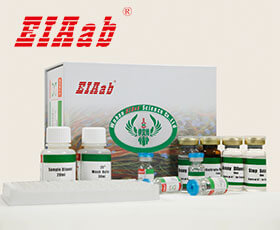VCP (基因名), Transitional endoplasmic reticulum ATPase (蛋白名), tera_pig.
产品名称:
Pig VCP/ Transitional endoplasmic reticulum ATPase Recombinant Protein
过渡性内质网atp酶
货号:
R15581p
商标:
EIAab®
监管等级:
别名:
15S Mg(2+)-ATPase p97 subunit, Valosin-containing protein, VCP, TER ATPase
序列号:
P03974
来源:
E.coli
种属:
Pig
标签:
His
纯度:
>90% by SDS-PAGE
浓度:
Reconstitution Dependent
形态:
Liquid
内毒素水平:
Please contact protein@eiaab.com The technician for more information.
应用:
存储缓冲液:
50mM NaH2PO4, 500mM NaCl Buffer with 500mM Imidazole, 10%glycerol(PH8.0)
存储:
Store at -20°C. (Avoid repeated freezing and thawing.)
研究领域:
Neurosciences
R&D 技术数据
更多信息,请参阅手册,或联系我们的技术支持: tech@eiaab.com.
通用注释
亚单元:
Homohexamer. Forms a ring-shaped particle of 12.5 nm diameter, that displays 6-fold radial symmetry. Part of a ternary complex containing STX5A, NSFL1C and VCP. NSFL1C forms a homotrimer that binds to one end of a VCP homohexamer. The complex binds to membranes enriched in phosphatidylethanolamine-containing lipids and promotes Golgi membrane fusion. Binds to a heterodimer of NPLOC4 and UFD1L, binding to this heterodimer inhibits Golgi-membrane fusion. Interaction with VCIP135 leads to dissociation of the complex via ATP hydrolysis by VCP. Part of a ternary complex containing NPLOC4, UFD1L and VCP. Interacts with NSFL1C-like protein p37; the complex has membrane fusion activity and is required for Golgi and endoplasmic reticulum biogenesis. Interacts with SELENOS and SYVN1, as well as with DERL1, DERL2 and DERL3; which probably transfer misfolded proteins from the ER to VCP. Interacts with SVIP. Component of a complex required to couple retrotranslocation, ubiquitination and deglycosylation composed of NGLY1, SAKS1, AMFR, VCP and RAD23B. Directly interacts with UBXN4 and RNF19A. Interacts with CASR. Interacts with UBXN6, UBE4B and YOD1. Interacts with clathrin. Interacts with RNF103. Interacts with TRIM13 and TRIM21. Component of a VCP/p97-AMFR/gp78 complex that participates in the final step of the endoplasmic reticulum-associated degradation (ERAD) of HMGCR. Interacts directly with AMFR/gp78 (via its VIM). Interacts with RHBDD1 (via C-terminal domain). Interacts with SPRTN; leading to recruitment to stalled replication forks. Part of a complex which includes CANX, DERL1, DERL2, DDOST/OST48, RPN1, RPN2, SELK, STT3A, VCP AND SELENOS. Interacts with WASHC5. Interacts with UBOX5. Interacts (via N-terminus) with UBXN7, UBXN8, and probably several other UBX domain-containing proteins (via UBX domains); the interactions are mutually exclusive with VIM-dependent interactions such as those with AMFR and SELENOS. Forms a complex with UBQLN1 and UBXN4. Interacts (via the PIM motif) with RNF31 (via the PUB domain). Interacts with DDX58/RIG-I and RNF125; interaction takes place when DDX58/RIG-I is ubiquitinated via 'Lys-63'-linked ubiquitin on its CARD domains, leading to recruit RNF125 and promote ubiquitination and degradation of DDX58/RIG-I. Interacts with BAG6.
功能:
Necessary for the fragmentation of Golgi stacks during mitosis and for their reassembly after mitosis. Involved in the formation of the transitional endoplasmic reticulum (tER). The transfer of membranes from the endoplasmic reticulum to the Golgi apparatus occurs via 50-70 nm transition vesicles which derive from part-rough, part-smooth transitional elements of the endoplasmic reticulum (tER). Vesicle budding from the tER is an ATP-dependent process. The ternary complex containing UFD1L, VCP and NPLOC4 binds ubiquitinated proteins and is necessary for the export of misfolded proteins from the ER to the cytoplasm, where they are degraded by the proteasome. The NPLOC4-UFD1L-VCP complex regulates spindle disassembly at the end of mitosis and is necessary for the formation of a closed nuclear envelope. Regulates E3 ubiquitin-protein ligase activity of RNF19A. Component of the VCP/p97-AMFR/gp78 complex that participates in the final step of the sterol-mediated ubiquitination and endoplasmic reticulum-associated degradation (ERAD) of HMGCR. Involved in endoplasmic reticulum stress-induced pre-emptive quality control, a mechanism that selectively attenuates the translocation of newly synthesized proteins into the endoplasmic reticulum and reroutes them to the cytosol for proteasomal degradation. Also involved in DNA damage response: recruited to double-strand breaks (DSBs) sites in a RNF8- and RNF168-dependent manner and promotes the recruitment of TP53BP1 at DNA damage sites. Recruited to stalled replication forks by SPRTN: may act by mediating extraction of DNA polymerase eta (POLH) to prevent excessive translesion DNA synthesis and limit the incidence of mutations induced by DNA damage. Required for cytoplasmic retrotranslocation of stressed/damaged mitochondrial outer-membrane proteins and their subsequent proteasomal degradation. Essential for the maturation of ubiquitin-containing autophagosomes and the clearance of ubiquitinated protein by autophagy. Acts as a negative regulator of type I interferon production by interacting with DDX58/RIG-I: interaction takes place when DDX58/RIG-I is ubiquitinated via 'Lys-63'-linked ubiquitin on its CARD domains, leading to recruit RNF125 and promote ubiquitination and degradation of DDX58/RIG-I.
亚细胞位置:
Cytoplasm
Cytosol
Nucleus
Endoplasmic reticulum
Recruited to the cytoplasmic surface of the endoplasmic reticulum via interaction with AMFR/gp78. Following DNA double-strand breaks, recruited to the sites of damage. Recruited to stalled replication forks via interaction with SPRTN (By similarity).
数据库链接
UniGene:
SMR:
STRING:
KEGG:
Pfam:
Uniprot:
该产品尚未在任何出版物中被引用。
[1].
猪过渡性内质网atp酶(VCP)重组蛋白是否是无菌的?
蛋白试剂瓶和蛋白保存液是经过高压灭菌的,但也不能保证蛋白是完全无菌的。如果要求蛋白是无菌的,可以用0.2微米的滤器对蛋白进行过滤。
[2].
猪过渡性内质网atp酶(VCP)重组蛋白的保存缓冲液是什么?
纯化后的蛋白保存在PBS(58mM Na2HPO4, 17mM NaH2PO4, 68mM NaCl, pH7.4)里,并往里面加入500mM咪唑和10%甘油。
[3].
怎样确定猪过渡性内质网atp酶(VCP)重组蛋白的浓度?
蛋白浓度的确定没有一个统一的标准,这主要取决于蛋白的氨基酸序列。伊艾博是根据不同测试的组合来测定蛋白浓度。考马斯亮蓝法、BCA法、氨基酸序列和氨基酸全序列分析法等都用来测定蛋白浓度。
[4].
猪过渡性内质网atp酶(VCP)重组蛋白蛋白保存条件是怎样的?
蛋白应保存在 -20℃或 -80℃条件下,为了避免反复冻融,可以将蛋白分装成小份保存。
[5].
猪过渡性内质网atp酶(VCP)重组蛋白是否可以用于活体实验?
重组蛋白没有用于任何的活体实验,因此蛋白的活性和半衰期是不确定的。
[6].
猪过渡性内质网atp酶(VCP)重组蛋白的保质期是多久?
在适当的保存条件下,从购买之日起蛋白可以稳定保存6-12个月。适当的保存条件是:蛋白保存在-20°C o或 -80℃,保证蛋白的保存浓度高于0.1mg/ml,限制蛋白反复冻融的次数。我们公司常规的质量检测保证所有产品在销售时都有可接受的生物活性。但是我们不能控制终端用户蛋白的保存条件。如果产品在有效期内出现问题,请联系我们的技术支持。
[7].
你们蛋白和抗体的报价是怎么样的?
我们将根据你需要的蛋白和抗体的大小进行报价。
[8].
猪过渡性内质网atp酶(VCP)重组蛋白是否能够提供蛋白片段?
我们现有的人的蛋白的序列可以有很多。你可以选择你感兴趣的靶向部分,我们将会按您的需求提供蛋白和抗体。
[9].
猪过渡性内质网atp酶(VCP)重组蛋白的货期或发货时间一般是多长?
具体指标的货期需要确定。最快一周,最长可能一个月。
反馈墙
评论数 : 0
所有用户
所有用户
默认排序
默认排序
最近
早期
目前还没有评论。






通知
规格
数量
单价 (¥)
小计 1 (¥)
小计 2:
¥

规格
数量
单价 (¥)






 验证序列:
验证序列:




 折扣:
折扣: